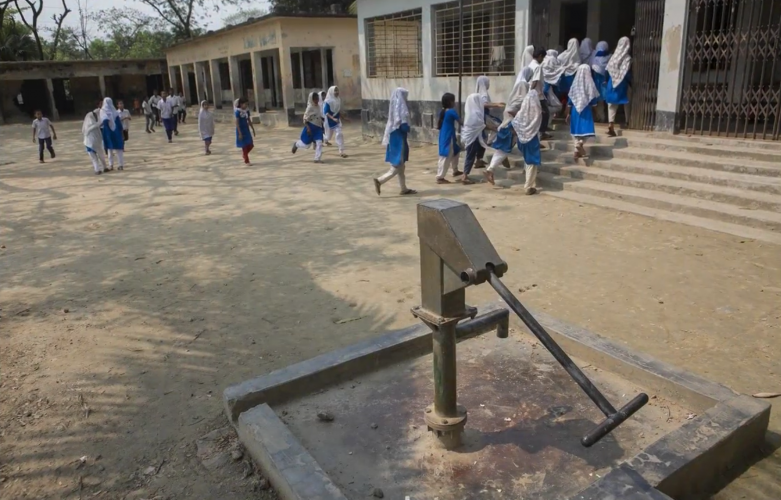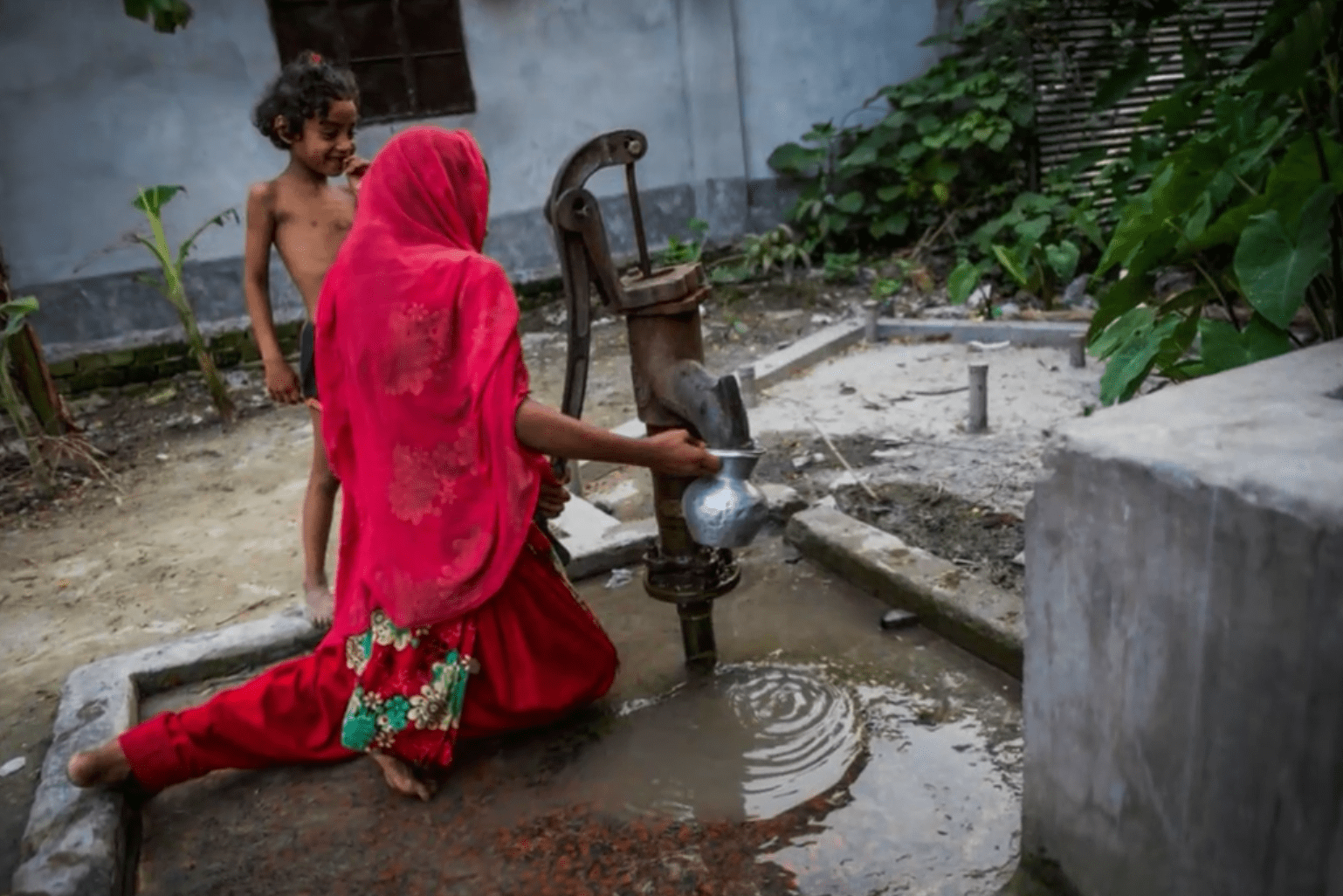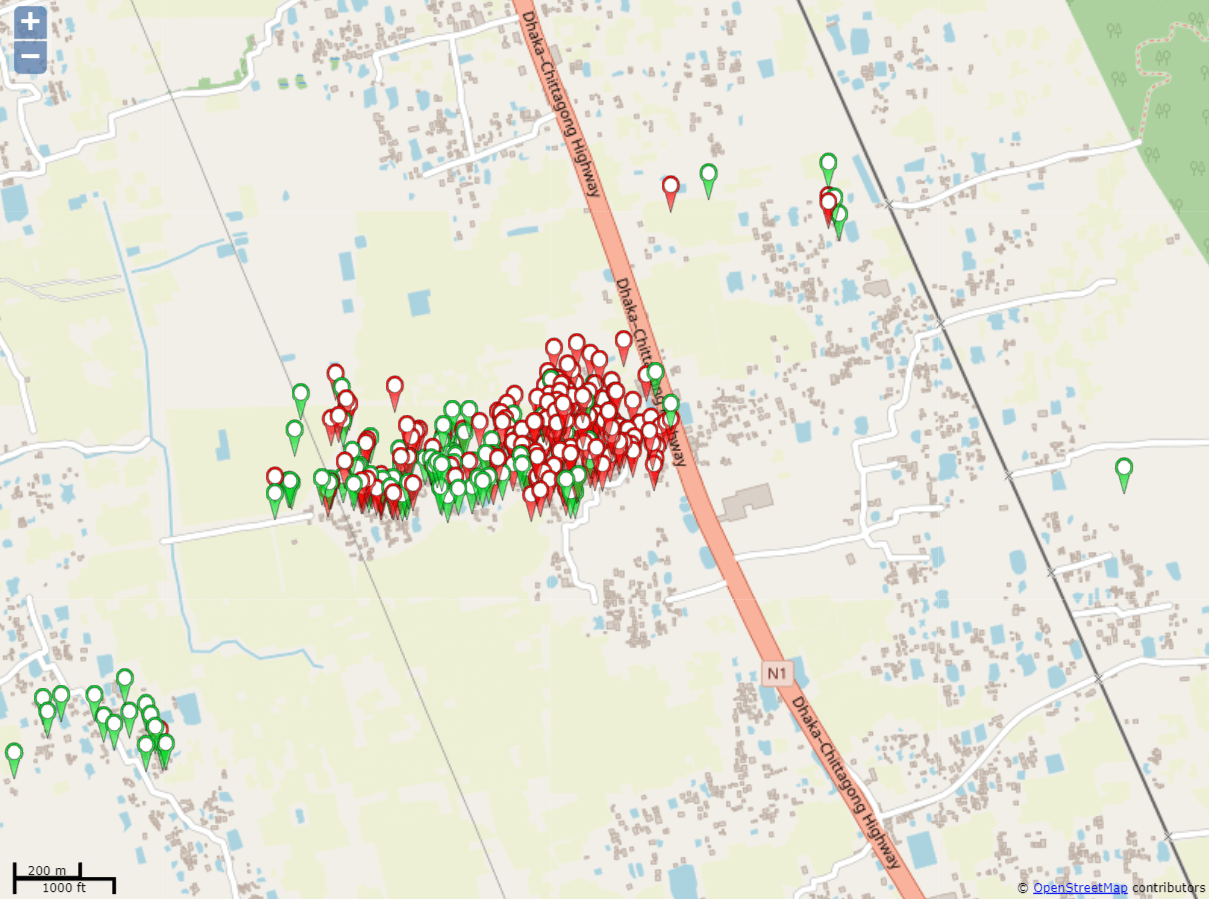BANGLADESH ARSENIC PROJECT
We claim that clean water is the right of every human being. Yet, around 20 million people in Bangladesh alone are suffering the consequences of consuming water contaminated with arsenic. What can we do about this? Chemists Without Borders has a solution, and you can be part of it!
We have been working in Bangladesh on this problem since 2014. After building a team of local and international experts and volunteers, we now have a model that we think will solve this issue nationwide.
We are validating the model in Teriail High School District in Sitakunda Upazila, near the city of Chittagong. But first things first:

What are the effects of arsenic poisoning?
Arsenic poisoning results in long term damage to health leading to early death. It seems that no organ escapes the menace of arsenic; skin blemishes and a variety of cancers, respiratory and cardiovascular illnesses are all effects of arsenic poisoning.
Where does the arsenic in the wells come from?
In general, it is not from industrial pollution but from the arsenic that is a natural component in the Earth’s crust.

What can be done?
The first step is testing the water in the well for arsenic. If high levels of arsenic are found, the well can sometimes be replaced by a second well that is free of arsenic. Another solution is to run the water through a sophisticated filtration system which removes arsenic and most other possible contaminants.
Why hasn’t that been done throughout Bangladesh?
It is largely because of cost. There are about one million public wells and ten million private wells in Bangladesh. Some have been replaced with safe wells, but many have not.
So what is this model Chemists Without Borders is proposing?
We do the following things:
1. We concentrate on getting safe water only to the high schools. This ensures that the students and teachers have safe water to drink at school. We do this by using sophisticated filtration systems on the high school well, rather than replacing the dozens or hundreds of contaminated wells in the high school district. Thus, our model is very inexpensive compared to the mass well replacement.
2. Then we give our attention to the wells in the community surrounding the school. We first recruit people to test each of the wells, which in most cases are private wells at the individual homes. The testers could be high school students or older college students who live in or near the community. They could also be retired people.
3. We had the following criteria for the testers:
a. They should live in or near the community, so they don’t lose time in travel.
b. They should have the time to work on testing (minimum 15 hours per week)
c. They should understand and have an interest in the project, so they don’t quit half way through it.
4. We tested all 320 wells in the Teriail community and found 2/3 of them to be contaminated with arsenic above the level of 50ppb (parts per billion) that is acceptable for drinking in Bangladesh.
5. We took down the GPS coordinates at each well location and put all of the wells on a map as shown below:

Click on the map above to redirect to the actual map webpage. Red dots are contaminated wells, and green dots are safe wells. You can zoom in and out and click on any well to get more information.
6. Communities that are interested in following our lead to test and map all their wells can contact us to get a more detailed tutorial that will help them avoid some problems that we encountered. (For example, we tried using the local high school students as testers but found they didn’t have enough free time for the project. We also tried using students from a university in Chittagong but found that traveling to the Teriail community took up too much of their time. Students from a small college that was near to Teriail were then able to complete the testing project.)
What is the next step after the community wells are tested and mapped?
We study the map of the wells.
a. If there are no safe wells in the community, we would set up a water delivery service, bringing water from the clean high school well to the homes that use wells contaminated with arsenic. However, this would involve purchasing delivery vehicles, water containers, building a shed for to clean and fill the containers with water. We would also need to hire and pay people to do the water delivery and to manage the operation.
b. If there are some safe wells in the community, as there is in the case of the Teriail community as the map above shows, we will select a different solution. We plan to set up a water sharing program, wherein some of the families whose wells were tested safe will share water from their well with some of their neighbors whose wells are contaminated with arsenic. The neighbors who take that water will pay a small fee each month to the family that is sharing their well, which will be an additional income for that family. Since the safe wells are distributed throughout the community, neighbors who take water from them will be able to walk to the well from their home to take the water, and there will be no need for the more costly delivery service. We will use students from the high school to visit monthly all the families who share water from their wells to do a monthly test for arsenic and to ensure that the program is working properly.
c. If almost all the homes have safe wells, with just a few contaminated with arsenic, we may just give the families with contaminated wells home arsenic filters. Then they can use the arsenic filters to get safe water from their own well. This strategy shows the necessity of 100% testing and mapping of the wells in the community, since, only when we see which wells are contaminated and how they are distributed, can we select the appropriate strategy.
Since the wells testing and mapping project can be done at a very low cost, and the sharing of wells will also be a very low cost operation, we believe that the strategy described above can be replicated across Bangladesh to solve the arsenic contamination problem in the communities in most regions in a matter of only a few years.
Why is this model so cost effective?
1. We don’t try to replace all contaminated wells, which would be very expensive;
2. We don’t provide water to all the homes, just the ones that use wells contaminated with arsenic;
3. We don’t provide all the water the family uses, just enough for drinking and cooking.
So you see, we maximize the resources available, minimize the work and the cost, and still provide water for drinking and cooking to the people who are otherwise consuming arsenic-contaminated water.
What is the value of this model?
The beauty of this model is that it is simple, yet effective, ambitious, yet realistic, extensive, yet cost-effective. More importantly, it is Bangladeshi youths who fuel this project, making it not just about water, but about empowerment of youths.
The Team
This project is transitioning to a Rotary Project which will be funded by a Rotary Global Grant. In addition to the water sharing program described above, the Rotary project will include bringing a water treatment system to the high school, repair of the school toilets, and sanitation/health/hygiene training for the students. The initial work was led by Ray Kronquist, our president, and Shahena Begum the Program Manager for Bangladesh. Rotary funding has been raised by the Rotary International Sponsor, San Francisco West Rotary Club, and the Host Sponsor, Chitagong Khulshi Rotary Club in Chittagong, Bangladesh. These funds will be matched by Rotary International to give a budget of about $40,000.
The project management team includes Bill Gilmore of San Francisco West, Mohammad Mohiuddin of Chittagong Khulshi, Shahena Begum and Achal Garg, a water treatment expert with the city of Cincinnatti, Ohio. John Aubertin is responsible for the mapping technology. Patrice Perillo of San Francisco West leads their fundraising team. Joan Chang, a director of CWB, deserves special recognition for introducing our project to San Francisco West and following up with the club on multiple occasions. Ray Kronquist serves as a consultant to the management team. Mohiuddin, as the president of the Host Rotary Club that is responsible for the execution of the project, is the Team Leader.
Many other volunteers have worked on the project during past years including Sumayea, Maliha, Ankita, Madani, Ehsan to name a few. A number of students from the Teriail High School, Asian University for Women and various volunteers from the local community helped keep this project moving forward.
Your contribution
Would you like to join this movement?
Until the Rotary Global Grant is received, Chemists Without Borders is funding this project. Considering the magnitude and impact of the project, the costs are not considerable. However, they are significant for an NGO like ours. Every monetary contribution makes a difference and we commit to investing the donations we receive in the best interest of the project. Only $50 keeps us going for another day, $250 for another week. There is no donation that is too small (or too big).
Should you wish to help, the people of Bangladesh will appreciate your donation. You can also contribute by volunteering. We are always looking for motivated individuals who are energized to spread awareness about our project and help us sustain an online presence that reflects our work in the field. We also appreciate any ideas, suggestions and comments that you would like to share with us

Team Contact
Mohammad Mohiuddin
mohiuddin.rotary@gmail.com
Tel: +880 176-788-3308
